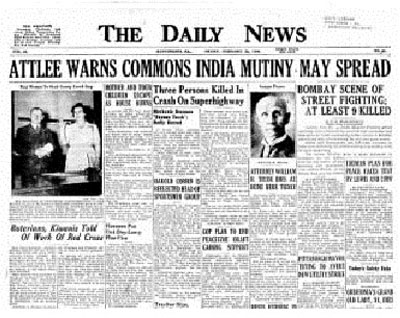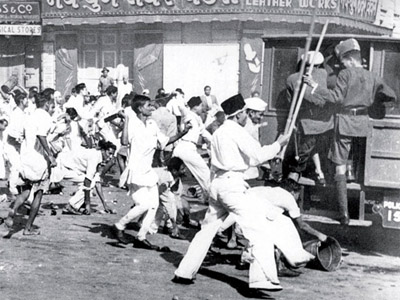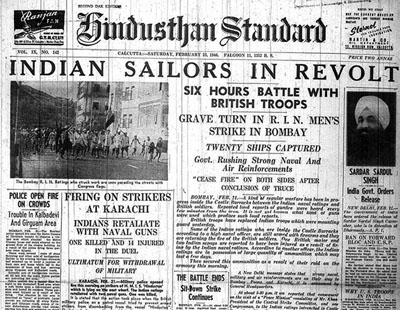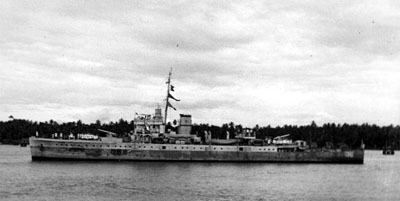|
Militants Strike, Britain Out
The 1946 Naval Indian Mutiny
Vinay Lal
The Naval Indian Mutiny
(RIN) mutiny, which ‘erupted’
on February 18, 1946, has long been overshadowed by the political trials of INA (Indian National Army) officers and soldiers which commenced in November 1945 and captured the nation’s attention. What was, of course, behind the INA was the charismatic figure of ‘Netaji’ Subhas Bose, whose storied exploits had been the talk of India and won him the affection of tens of millions of his countrymen and women. In 1939, running for the Presidency of the Congress for a second time, against the express wishes of Gandhi, Bose had triumphed only to discover within weeks that the Congress machinery was behind the Mahatma and that he could not function effectively as President of the Congress. In 1941, while placed under house arrest, Bose staged a daring escape from his Calcutta home from where he made his way to Afghanistan and eventually to Germany where he managed to get an audience with Hitler. All this was theatrical enough, but merely icing for the cake: in 1943, he took over the Azad Hind Fauj (INA) and in October that year he formed the Provisional Government of Free India. The INA would see military action, most famously at Imphal and Kohima, and in Burma, but months before the war ended the INA had been decimated. Bose’s own immediate future was uncertain at best, considering that Britain triumphed at the end of the war and that he had fought for the enemy, but providence had something else in store for Bose. He is reported to have been killed in an air crash near Taiwan in September 1945. Many in India refused to believe reports of his death; some still do so. It seemed a bizarre, certainly an unfair, death for one anointed ‘Netaji’, the hero of the nation.
The country was still reeling from the death of Subhas Bose when the British decided to initiate legal proceedings against some of its officers on charges of sedition, murder, and waging illegal war against the King-Emperor. That may explain, in part, why the RIN mutiny went into near obscurity, but oddly enough it was the saga of the INA that was, again in part, the catalyst for the RIN strike. What cannot be doubted is that the naval mutiny was, as Sumit Sarkar, one of India’s leading historians, wrote, ‘one of the most truly heroic, if also largely forgotten, episodes in our freedom struggle.’ The rebels themselves underscored the importance of what they had achieved: ‘Our strike has been a historic event in the life of our nation. For the first time the blood of men in the Services and in the streets flowed together in a common cause. We in the Services will never forget this. We know also that you, our brothers and sisters, will not forget. Long live our great people! Jai Hind!’

The enlisted sailors (or ‘ratings’, as they are known in naval jargon) had grievances galore. They were recruited under false promises of a decent salary, prospects for some advancement, good food, and a steady uniformed job in the defence of their nation. What they got in return was rotten food, poor working conditions, and the racial insults that Indians were expected to bear chin up, even in good humour, with the alleged stoicism of their English officers. It is not only conventional to think that subalterns cannot think for themselves, but also that they cannot look beyond their own little worlds to the world outside. Yet, the words of the ratings, and the pronouncements of the Naval Central Strike Committee, formed to represent the demands of the rebels, unequivocally suggest that they had other concerns as well. The end of the war meant that men would be released back into civilian life and prospects for employment for demobilised men were poor. Moreover, the ratings objected to the fact that they were being deployed in Indonesia, where the Dutch were determined to restore the colonial order after the Japanese interregnum, to stifle the genuine political aspirations of Indonesians. Besides all this, there was also the brute fact that there was a yawning gap between the treatment of British and Indian sailors.
On February 18, the ratings at the HMIS Talwar, a signals training establishment, struck. The groundwork, one might say, had been laid weeks before. The Commanding Officer of HMIS Talwar was given to vile racial abuse and contemptuous treatment of the ratings and had earned notoriety among them. He commonly addressed them as ‘sons of bitches’, ‘sons of coolies’, and sons of bloody junglees’. On 1 December 1945, the HMIS Talwar and other naval ships and shore establishments were expected to be displayed to the elites of the city, but early that morning British officers found the parade ground sprayed with signs, among them ‘Quit India’, ‘Revolt Now’, and ‘Down with the Imperialists’. This was later determined to be the handiwork of Balai Chand Dutt, a senior telegraphist who had served with the navy for five years, and whose published memoirs furnish one of the key expressions of subaltern dissent. Pramod Kapoor, whose book on the RIN mutiny is being released as this essay is being written, has shared precious and little-known details which suggest that, however spontaneous the uprising, the mutineers worked with the design of precipitating the revolt. As one instance, the young journalist, Kusum Nair, later the author of such classics on Indian agriculture as Blossoms in the Dust and In Defence of the Irrational Peasant, engineered crushed stones to be placed on the evening of February 17 in the dal that was dished out to the ratings. The food was customarily inedible; more so would it be on the day of the uprising.

“Rioting on the Streets in Bombay”, Royal Indian Navy Mutiny, 18-23 February 1946
Just how widespread was the disaffection became clear soon enough: in less than three days, at the height of the strike, the revolt had spread to over 75 ships, 20 shore establishments, and 20,000 sailors, all under the age of 26. The British were inclined to respond with force, more particularly because, as Field Marshall Wavell, the Viceroy of India, put it in a telegram to Prime Minister Clement Attlee, the ‘example of the Royal Air Force, who got away with what was really a mutiny, has some responsibility for the present situation.’ The alarm in the establishment can be gauged from the fact that, astonishingly, Admiral John Henry Godfrey declared that he was prepared to see the navy decimated but that he would not tolerate insurrection. What is not less remarkable is the widespread support the striking ratings received from workers and the residents of Bombay who responded to the Naval Central Strike Committee’s call for a city-wide hartal with enthusiasm. Though, as shall be seen shortly, neither the Congress nor the Muslim League, the two main political parties of the day, were supportive of the strike, common people engaged in uncommon acts of fraternisation. Many of the ratings had been on a hunger-strike; others, besieged by British troops, had run out of food; but, as the newspaper accounts and other testimonials suggest, people freely distributed food to the ratings and shopkeepers even encouraged them to take whatever they needed and refused payment. Meanwhile, the strike spread to naval establishments over the country, and in Karachi the HMIS Hindustan was subdued after a gun battle. The state of affairs in Bombay is suggested by the headlines, generally spread across the entire length of newspapers, that appeared on February 23, the day after Bombay no longer seemed under the control of the colonial state: ‘Bombay in Revolt: City a Battlefield’ (The Hindustan Times); ‘Nightmare Grips Bombay’ (Dawn—then published in Bombay); and ‘Rioters Machine-Gunned in Bombay (The Statesman).

Around 400 people would be killed in the conflict. Yet, after all this, the strike came to an end on February 23—suddenly, all too suddenly. The capitulation of the Strike Committee is said to have been forced by the fact that, barring Aruna Asaf Ali, none of the political leaders were behind the strike. One might reasonably expect that Gandhi, who at least took a principled stand against violence, would throw in his weight to persuade the ratings to give up their arms. Just how much influence he could still exercise in such an affair is a question that few have asked. It is, nevertheless, the position of the other principal political figures that has in the historiography of the naval mutiny come under scrutiny and sometimes withering criticism. Nehru is said to have wanted to rush to the sailors and lend his support to them, but the conventional narrative states that Patel, who had been authorised by the Congress to converse and negotiate with the members of the Strike Committee, dissuaded Nehru from doing anything so rash. It is on Patel’s assurance to the ratings that their grievances would be addressed, and that equally they would not be punished if they surrendered, that they are said to have called off the strike.

HMIS-Hindustan after the British reasserted their control
As Kapoor has detailed in his book, 1946—The Last War of Independence: Royal Indian Navy Mutiny, the story of the betrayal of the ratings is one of the more wretched chapters in the history of Indian nationalism and the failure of political leadership. The sailors were imprisoned, put into camps, dismissed without payment of past dues, and sent back to their villages. They would be lost to history. Yet ‘failure’ is an anodyne word to describe the hard-boiled realism that prompted Patel, Azad, Nehru, and Jinnah to throw the ratings to the wolves. That is a reasonable interpretation, especially from the standpoint of those who have always been inclined to view the Congress as a bourgeois organization that was only interested in the trappings of power. Independence was on the horizon and an insurrection in the armed forces of the nation—a nation that was about to be parcelled out between the Congress and the Muslim League—was not to be tolerated. As Patel (in)famously wrote in defence of his action to persuade the ratings to surrender, doubtless with the steely pragmatism and determination for which he is now admired by the country’s political leaders, ‘discipline in the Army cannot be tampered with... We will want the Army even in free India.’
There are far too many other interesting questions that emerge from the Royal Indian Navy mutiny of 1946 that cannot be addressed here, but two points may, in conclusion, be raised for further reflection on the part of the reader. The communists alone are credited with having given the ratings their full support, but one must recall that communists had lost ground owing to their failure to support the Quit India movement. They had now found an opening for redemption that they were scarcely likely to give up. What is of course in many ways distinctive about Indian communism is the fact that there are many strands within it, and that most Indian communists have long been reconciled to working within the constitutional framework. One suspects that a more nuanced reading of the communist support of the mutiny is needed, more particularly because in most countries communist regimes have been ruthless in suppressing dissent within the armed forces. Secondly, nearly every commentator has pointed to the fact, highlighted by the ratings themselves, that Hindus and Muslims found themselves joined in a common cause and exhibited what appear to be feelings of brotherhood. If that was indeed the case, then there is all the more reason, given the fact that some within India would like to move the country towards the path of a Hindu rashtra, to celebrate the ability to transgress the religious divide. It is a pity that this act of insurrection, coming at the tail end of the long struggle for freedom, has remained hidden from history considering that in its course and outcome it has something in it for nearly everyone, not least for those who think that it hastened the end of the British Raj.
[This is a slightly revised version of a piece first published under the same title at abplive.in.
Source: https://vinaylal.wordpress.com]
Back to Home Page
Frontier
Vol 54, No. 43, April 24 - 30, 2022 |
